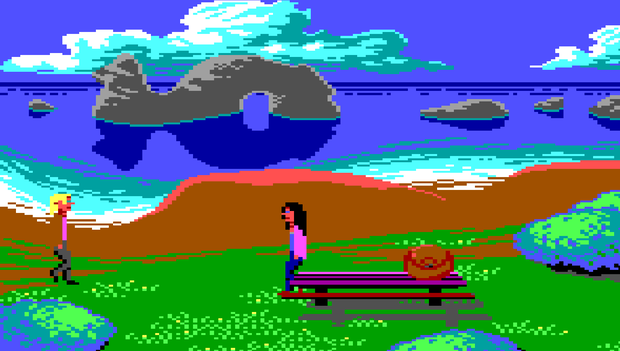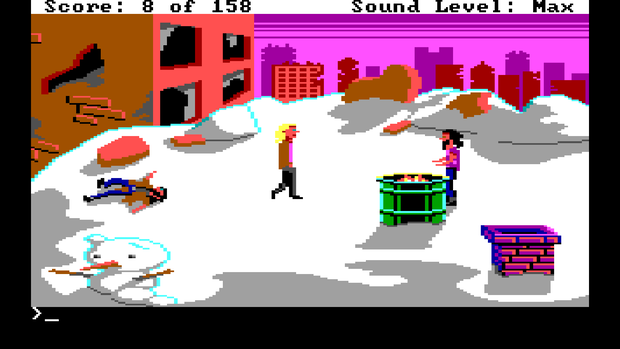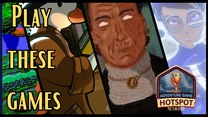Tachyon Dreams Anthology review

- 0 Comments
Eighties-inspired time-travel freeware series gets a second chance as an amusing, nostalgia-fueled updated commercial remake
Cosmic Void is fast becoming one of the more prolific indie studios in the adventure game community. In between two new releases (Twilight Oracle and the upcoming Devil’s Hideout) the solo developer decided to bundle a trilogy of three older and smaller freeware games in an enhanced commercial version. These episodes or “chapters” are now tied together in one continuous story as Tachyon Dreams Anthology, with some new content added along the way. At first I thought it was a step backwards compared to the studio's other games, but it didn’t take long to realize what a true homage it is to the graphics and gameplay from classic Sierra text parser adventures like King’s Quest: Quest for the Crown, Leisure Suit Larry in the Land of the Lounge Lizards, and of course Space Quest: Chapter I – The Sarien Encounter. The latter in particular clearly influenced this game very much, especially regarding the humor that makes it such a fun couple hours to complete.
You play as Dodger, not a janitor but a blond mullet-sporting dishwasher on the Penrose Interstellar Space Station (yes, that acronym is exactly what you think it is…). While sleeping on the job, suddenly he finds himself rudely awakened by a sounding alarm. As he enters the station’s control room, Dodger realizes everyone has vanished, making him the sole crew member remaining. Apparently a series of temporal anomalies is disrupting the space-time continuum, and the on-board AI computer system named Audrey has no choice, much to her annoyance, but to put Dodger on the mission to find out what has happened. Audrey assigns him the use of a remote control with which he can travel through time, and a handheld computer to keep in contact with her.

You control Dodger with the directional keys, and when you want him to take action, you have to type commands using the text parser. A short tutorial at the start explains the basics of this interface (and can be accessed again anytime during your playthrough) and immediately gives the best piece of advice for playing games of this style: look first, act later. The most important hotspots are revealed in the description of your current location, but you can still interact with other stuff you see – if you can come up with their correct names, that is. This can be a task in and of itself, as Tachyon Dreams features colorful yet low-res, chunky-pixel EGA graphics that can make it hard to identify some things.
Creative use of the text parser is usually very rewarding in such instances, though I never had to search long for alternatives to my initial failed command attempts. When it comes to solving the actual puzzles, there was only one specific noun I couldn’t immediately think of. While trying out stuff just for fun, however, there are indeed some limitations to the words the parser recognizes. Sometimes you have to think beyond the basic verb interfaces of other games you might be familiar with. For example, when you need to apply a sponge-like inventory item, a simple USE will not garner the required result. You really need to specify what you want to do with the sponge. And don’t worry if you type something wrong: there are a couple of generic yet funny enough replies from the narrator insulting your vocabulary.

In the first part of the game, you skip back and forth from your space station in the present to a forest 300 million years in the past, to a post-apocalyptic city 85 years in the future. You have to solve a series of traditional inventory puzzles by finding objects in one era, using them in another, and steadily progressing through the story. There is no playing with the timelines, though. These are three standalone eras in different geographical locations, and your actions in the past don’t affect the present or future. You can interact with other characters, though their number is limited, as is the number of locations in each time period. This keeps the difficulty level relatively low, though the puzzles can still be quite challenging. The function of many items can be deduced quite intuitively, but many others are there to distract you as red herrings.
Subsequent chapters will take you to even wilder locales as you slowly uncover the plot, which involves two warring alien species – the Margdonians and the Tgorodians. Although linked together now as a continuous narrative, the transitions between chapters are still a bit abrupt, and I always felt like I had missed some context. This is at least partly due to the fact that Tachyon Dreams doesn’t feature any animated cutscenes. Developments in the story are told through huge text blocks through which an omniscient narrator describes what happens to Dodger instead of showing it. For the most part this didn’t bother me, though I would’ve really liked to see what Dodger’s own “Jonah and the whale” experience looked like.
While the game is definitely text-heavy, I didn’t notice all that much because the writing is truly sublime. Other than the dense, chapter-switching blocks of exposition, it’s crisp, succinct, and error-free – and very funny, without being too silly or over the top. The humor is of the sarcastic variety, with the narrator as well as other characters looking down on Dodger, or straight out insulting his – and thus your – intelligence, when you try something that’s only half a solution, like trying to feed a hungry man a radioactive fish. There’s some situational humor as well, such as when Dodger accidentally swallows a key item and has to… sit down for a spell.
And yet as amusing as it is, I was surprised to find that the last part of the game isn’t afraid to address more serious themes. When you’re dealing with time travel, you can’t help think about your own past, and whether you would do things differently if you could go back. Tachyon Dreams suggests that it’s better to come to terms with that past, that things happened for a reason and even though you might not like what occurred, there’s no guarantee that your life would turn out any better with different decisions. So, the smart move would be to try to accept your life as it is now and try to make the best of the future.

This philosophy is explored when Dodger’s travels take him back to a pivotal moment in his own life, an event that pretty much destroyed his self-esteem and ultimately landed him in that dead-end dishwashing job. It’s at this point that Dodger, pretty much a one-sided character to that point, becomes something more than a simple sprite, more than that silly dishwasher. Forced to relive those bad moments, Dodger learns he isn’t the loser he took himself for ever since, and this adventure he’s being thrust upon might just be what he needs to pull himself together and return a feeling of worth into his life.
True to the game’s 1980s-inspired presentation, the characters aren’t voiced, but I didn’t really miss it. The lack of music and sound effects is a bit unnerving, though. You get the occasional electronic beep when you push a button, a swoosh when a door opens, and a short jingle when you do something right and get a point – also in classic Sierra style, you can score a total of 158 points – but the environments are otherwise completely silent. The start and end of a chapter feature some old “internal speaker” kinds of synthesized boops and bleeps, but the music will be suddenly cut off as soon as you’re back in control, leaving you with the feeling of having been struck temporarily deaf.
Thankfully the game does improve on its unforgiving inspirations by being more user-friendly. You can look at everything from a distance, without the prompt that you’re not close enough. Actually manipulating items still requires you to move first, though instructing Dodger to pick them up is sometimes possible from a distance. There aren’t any dead ends or unwinnable states. Nor can you die. While this might be a relief to many gamers, it also takes away a bit of the fun in my opinion. An automatic rewind to right before you made a wrong move had the potential for even more humor without the random deaths becoming frustrating, inspiring some witty text messages, even if not accompanied by funny animations.
There are some obscure optional actions available somewhere, because after two and a half hours of gaming, I only got up to 152 points! Should this happen to you as well, you can easily go back and search for the points you’re missing thanks to the manual save system, enabling you to store your progress anytime you want. There are only eight save slots, but since you can’t really do anything wrong, that’s plenty for a game of this length.
Final Verdict
Compared to most modern graphic adventures, Tachyon Dreams Anthology might shock newcomers to the genre with its blatantly old-school graphics and user interface. But this is a game that must be judged on what it’s trying to do, and that’s where it largely succeeds. It’s a nostalgic 80s-era Sierra clone, with blocky pixel art and a text parser for commands instead of simple point and click. Objects are sometimes crudely presented visually, and a better than basic knowledge of the English language is needed, but I hope people who aren’t turned off by its limitations will give this game a go. Sci-fi usually isn’t my cup of tea, but the simplified presentation made for an enjoyable trip down memory lane. And even for those who didn’t grow up with adventures in the 1980s, not only does this game shower you with great humor, it succeeds in making you think about your own life and the path you’ve walked in the process.
Hot take
If you’re used to a simple point-and-click interface, Tachyon Dreams Anthology might take some getting used to, but its humor-filled sci-fi story is a wonderful homage to the text parser adventures of the 1980s.
Pros
- Wonderfully replicates the best parts of classic text parser graphic adventures
- Wisely avoids the more punishing pitfalls like dead ends and random game overs
- Writing is good for plenty of laughs
- Challenging enough inventory puzzles ensure a well-balanced difficulty
Cons
- Heavy on descriptive text to compensate for the lack of cinematics
- Sound effects and music make only rare appearances
- Missed opportunity to add rewindable funny deaths
Johnny played Tachyon Dreams Anthology on PC using a review code provided by the game’s publisher.











0 Comments
Want to join the discussion? Leave a comment as guest, sign in or register in our forums.
Leave a comment